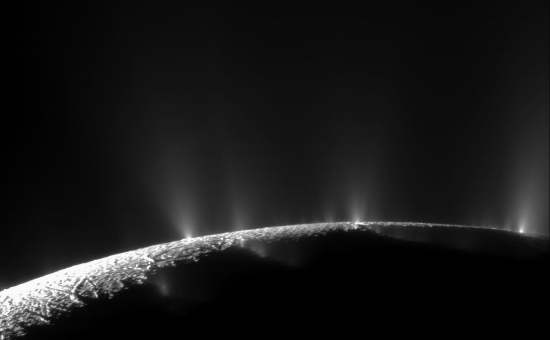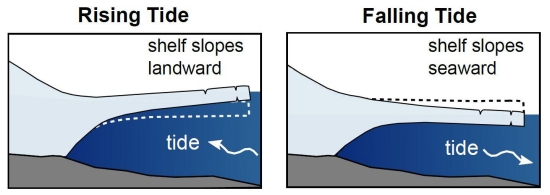We could do with more information about how ice behaves on a gas giant’s moon. We’ll need this knowledge to understand the behavior of crustal ice on places like Europa and Enceladus, where oceans may provide sub-surface venues for life. One approach into the subject is to look at ice right here on Earth; specifically, the Antarctic ice shelves. A new study out of NASA’s Goddard Space Flight Center applies a model based on Antarctic data to the fractured south pole of Enceladus, probing tidally driven stress and seismic activity within an ice shell.
We assume that tidal stresses produced by the moon’s interactions with Saturn, as well as the planet’s larger moons, keep the interior of Enceladus warm, while at the same time producing cracks and accounting for the geysers of water vapor Cassini found erupting from the so-called ‘Tiger Stripes’ (fractures) at the southern pole. The tides of Enceladus must be massive, and learning about the seismic activity they induce offers a key to the movement of the ice.

Image: Dramatic plumes, both large and small, spray water ice and vapor from many locations along the famed “Tiger Stripes” near the south pole of Saturn’s moon Enceladus. The Tiger Stripes are four prominent, approximately 84-mile- (135-kilometer-) long fractures that cross the moon’s south polar terrain. Credit: NASA/JPL/Space Science Institute.
Future lander missions will benefit from knowing where and when icequakes occur on Enceladus. Led by Kira Olsen (NASA GSFC), the research effort described in the Journal of Geophysical Research: Planets focuses on data collected by seismometers deployed along Antarctica’s Ross Ice Shelf between 2014 and 2016, with an eye toward examining the tensile strength of the ice and the stresses on it. The researchers compared these data with satellite imagery of the same area.
They found that most icequakes on the Ross Ice Shelf happened as large rifts in the ice pulled apart, which occurs in conditions of falling tides. The team used the Antarctic data to produce models of seismic activity on Enceladus, having observed that “seismic activity at the Antarctic rifts is sensitive to both the amplitude and the rate of tensile stress across the rifts.”

Image: Ice shelves floating on Earth’s Southern Ocean rise and fall with tides, causing rifts, fractures. Icequakes occur most frequently when falling tides pull the rifts apart. Models suggest seismic activity on Enceladus likely corresponds to the tides inside the moon. From figure 1 of the new study. Credit: AGU/ JGR: Planets.
The paper makes the case that the similarities between Antarctica and Enceladus are strong, homing in on a pair of interior, parallel fractures in the central part of the Ross Ice Shelf:
These internal rifts, named WR4 and WR6 (for Western Ross rifts 4 and 6; e.g., Walker et al., 2013), exist within a geophysical environment closely analogous to the TSF(Tiger Stripe Fractures) within the Enceladean icy shell. Physical similarities include (1) the Antarctic rifts are concentrated regions of deformation within the ice shelf, as are the TSF within Enceladus’ ice shell, (2) the Antarctic rifts undergo daily cycles of tidal deformation, similar in time scale to the tidal cycle that the TSF undergo throughout an Enceladean orbit (?33 h), (3) the Antarctic rifts share similar geometries with the TSF (Table 1), and (4) fracture mechanics and seismicity generation is expected to be similar between the Antarctic and Enceladean environments.
The authors combined the Antarctic data with calculated stress values along Enceladus’ Tiger Stripes to predict seismic-activity levels along the ice-shell fractures. The result: Seismic activity on Enceladus should peak when the moon is 90°–120° past the closest approach in its orbit around Saturn, with seismic activity levels decreasing by about 50 percent during the last 180° of the orbit. The activity along the cracks, according to the model, should not be massive, but rather a series of small movements and fractures producing sustained stress on the ice, consistent with our observations of plume eruptions at the Tiger Stripes, which tend to be discrete rather than simultaneous ‘curtain eruptions’ along an extended fracture segment.

Image: A satellite image of the research study site on the Ross Ice Shelf in Antarctica (top) shows two rifts in the ice from rising and falling tides. Similarly sized “Tiger Stripe fractures” crease the ice in Enceladus’ South Polar Terrain, in an image captured by the Cassini Imaging Team. Also from figure 1 of the new study. Credit: AGU/ JGR: Planets.
A useful approach, according to the authors, would be for any future mission to Enceladus to place seismometers within 10 kilometers of these fractures. For now, while Europa is in our thinking with the upcoming Europa Clipper and JUICE missions, no Enceladus missions are in the works. But the scientists see their model offering insights into other icy moons:
Though we focus this study on Enceladean rifts, the relationship that we observed at the Ross Ice Shelf rifts between tensile stress, stretching rate, and seismic activity could be applicable to tidally forced seismicity in other planetary settings. The key input needed would be robust models of stress evolution through an orbital cycle at the fracture locations of interest. Future work applied to Titan would be especially insightful, given the collection of on-ice seismic data planned as part of the Dragonfly mission. Observation and study of the energy generated by icequakes will be one of the primary ways such missions to icy worlds advance our understanding of a range of scientific goals, from better understanding tidal tectonics, surface deformation, cryovolcanism, and material properties, to seismically probing the structure of the ice and sub-ice interior. Our study demonstrates the utility of even a single seismograph for these future missions.
The paper is Olsen et al., “Projected seismic activity at the tiger stripe fractures on Enceladus, Saturn, from an analog study of tidally modulated icequakes within the Ross Ice Shelf, Antarctica,” JGR: Planets 21 May 2021 (full text).



This should also happen on Enceladus, impact gardening and radiation.
Surface of Jupiter’s Moon Europa Churned by Small Impacts.
https://www.nasa.gov/feature/jpl/surface-of-jupiter-s-moon-europa-churned-by-small-impacts
More on this story tomorrow.
And luckily less radiation an Enceladus. With the study on methane I am slowly starting to consider the idea that this 500 km miniature moon might host micro organisms. Yet the layer of liquid water might still be relatively thin around most of this moon, with the idea often mentioned hypothesis of a thicker layer at the south pole. Even so it’s still a rather small volume, if life is found we might have to consider the idea that several worlds with subsurface liquids could be host to microbial life, and perhaps even revamp the idea of life’s origin to the idea that the original nebula contained pre biotic molecules that had the potential to jump start life in any suitable niche it ended up in.
https://www.researchgate.net/publication/352201186_Bayesian_analysis_of_Enceladus%27s_plume_data_to_assess_methanogenesis
If the TSFs on Enceladus are analogous to the Antarctic ice shelf fractures, they may also give us a better idea of the thickness of the icy crust. In particular, do the TSFs appear where the ice is thinner (the “shelf”) and absent where the ice is thicker (the “glacier anchor” on the land)?
Ice penetrating radar should offer the “ground truth” for such a hypothesis. In addition, if the crust floats around on the subsurface ocean over millions of years, the position and estimated age of the TSFs could indicate the history of those movements in the past.
Paul, I got an alert to this story from “hi@follow.it”
If I’m on your list, why do I need that? Is it bogus?
Thanks.
Should be the new email service kicking in. I assume it had the story enclosed? We’re using the follow.it service to forward emails since Google shut down its Feedburner service.
Hi Paul
The email service is working for me now, just make sure its not in your spam folder folks.
A very interesting look at Enceladus here Paul I was looking forward to reading your comments on it, I need to look up the paper too.
The Europa post will be a good read too.
Hopefully in the distant future lander’s will be sent to both Moons.
Cheers Edwin
Glad to hear the email is working, and sorry about the spam folder. That shouldn’t be happening, and we’re trying to work out the problem. And yes, let’s hope for those landers!
Given that any microbial life might well be expelled in the plumes from Enceladus, what are the chances of certain ‘clever’ elements of such becoming ‘wary’ of venturing too close to the vents?
Probably about as “wary” as terrestrial bacteria are about straying too far from oceanic smokers, anaerobic habitats, avoiding consumption by predators, and not straying from bio labs and the petri dishes where they are warm and well-fed. ;)
Could this be the holy grail for life? Nickel and Sulfur common in planet cores and meteorites could be the best place for the origin of organic life on Earth and Enceladus?
Oldest fossils of methane-cycling microbes expand frontiers of habitability on early Earth.
https://www.europlanet-society.org/oldest-fossils-of-methane-cycling-microbes-expand-frontiers-of-habitability-on-early-earth/